Velotric Summit 1 Vs Specialized Turbo Tero X Comparison
Hybrid e-bikes for work and play, but which is best suited for the type of rider that you are?

The term “SUV-style e-bike” has gained traction in recent years, referring to hybrid e-bikes designed for both work and play. These bikes combine the practicality of a commuter-capable ride for getting to and from work with the ruggedness needed for off-roading, whether it’s on local greenways or possibly blue trails. While owning dedicated bikes for each purpose would be ideal, most of us have limited budgets and finite garage space, making the rise of this versatile category easy to understand.
Here, we’re comparing two popular options on opposite ends of the pricing spectrum: the Velotric Summit 1 and the Specialized Turbo Tero X. Velotric is an emerging brand in the affordable e-bike space that has made strong impressions with early models, while Specialized is a long-established, celebrated name in the industry.
Let’s approach this comparison with open eyes: this isn’t about declaring one bike “better” than the other. There’s a clear reason the Tero X costs nearly 2.5 times as much as the Summit—it comes with refinements and features the Summit doesn’t offer. Instead, we’ll examine how wide the performance gap is and determine which bike might better suit certain types of riders. After all, “entry-level” rides these days are surprisingly good and the gap is more narrow than you might think, but there might be things seasoned riders still crave on the top end.
First, let’s break down their key differences, starting with the motors. The Velotric Summit features a rear hub motor delivering 750W of power and 90Nm of torque, along with a throttle and the option to use either a torque or cadence sensor. This means it packs plenty of muscle, while offering versatility if you toggle the engagement sensor. You can get a natural-feeling ride for off-road precision with the torque sensor or an easy, relaxed experience for your daily commute by running the cadence sensor.
The Specialized Turbo Tero X (specifically the 5.0 model we tested) is equipped with a mid-drive motor rated at 250W and 70Nm of torque. It’s designed for speed and excels at providing a seamless, natural ride—like a supercharged version of yourself.
While these bikes share plenty of overlap and are both capable of handling diverse tasks, their differences in design and performance will influence which one suits you best. It’s a bit like dessert preferences: my wife loves Black Forest cake, while I prefer German Chocolate. We’re both chocolate cake fans, but we enjoy our experience in different ways. Let’s dive into this comparison to see which bike satisfies your taste buds!
|
Velotric Summit 1 |
Specialized Turbo Tero X 5.0 |
Velotric Summit 1 Vs Specialized Turbo Tero X 5.0: Test Results & Key Specs
| Velotric Summit 1 | Specialized Turbo Tero X 5.0 | |
| Testing Results | ||
| Range Test – Maximum PAS | 36.47 miles, Tested to Class 2 speeds, 20mph max | 36.13 miles, Tested to Class 3 speeds, 28mph max |
| Range Test – Minimum PAS | 73.39 miles | 73.75 miles |
| Hill Test – Throttle | 1:09, 15.7mph | N/A |
| Hill Test – Pedal | 1:13, 14.9mph | 1:41, 10.7 mph |
| Speed Test – Class 3 | (Middle setting “Trail” mode) No Motor: 11.2 mph PAS 1: 13.5 mph PAS 2: 14.9 mph PAS 3: 17.6 mph PAS 4: 21.4 mph PAS 5: 29.2 mph |
No Motor: 12.9 mph Eco: 20 mph Trail: 22.7 mph Turbo:27 mph |
| Brake Test | 23’1″ | 21’11” |
| Electrical | ||
| Motor | Rear hub, 90Nm Torque, 750W (nominal), 1300W (Peak) with a Torque Sensor | Specialized 2.0 mid-drive, 70 Nm Torque, 250 Watt (nominal), 470 Watt (max) |
| Battery | 48V, 705.6Wh, IPX7, Certificated to UL 2271, removable | Specialized U2-710, 710Wh, Certificated to UL 2271, removable |
| Charger | 48V, 3A Fast Charger | 42V, 4A w/ Rosenberger plug, 100-240V |
| Pedal Assist | 3 Modes (Eco, Trail and Boost) 5 Levels within each mode, Class 1, 2, 3 capable. | 3 Level Assist (Eco, Trail, and Turbo), Class 1, 3 |
| Display | 2.8″ Full color, high brightness, Bluetooth, adjustable angle, app connectivity, Apple Find My | MasterMind TCD, w/handlebar remote, built-in anti-theft feature, Bluetooth® connectivity, customizable display pages |
| App | Velotric | Specialized |
| Throttle | Yes – removable | No |
| Key Components | ||
| Frame | Triple-Butted Aluminum Alloy, available in two sizes and three colors | E5 Aluminum, available in four sizes and two colors |
| Brakes | Shimano Hydraulic Disc Brakes w/180mm rotors front and rear, 2-piston caliper | Sram Code R, 4-piston caliper, hydraulic, 200/180mm front/rear |
| Drivetrain | Shimano Altus 1×8, 44t chainring, 9-32t cassette | SRAM GX Eagle, 12-speed, NX derailleur, 38t emtb specific chainring, 11-50t cassette |
| Shifters (type) | Shimano Index Shifter | SRAM GX Eagle, trigger, 12-speed, single click |
| Fork | Hydraulic suspension 120mm travel with Lock-out, 15x110mm thru-axle | RockShox 35 Silver TK, lockout, 130mm, fender mounts |
| Rear Suspension | None | RockShox Deluxe Select R, rebound adjust, 45x190mm |
| Tires | Kenda 27.5×2.6″ MTB puncture-resistant tires | Front Tire: Ground Control Grid T7, 2Bliss ready, S: 27.5×2.35, M-XL: 29×2.35”
Rear Tire: Ground Control Grid T7, 2Bliss Ready, 27.5×2.35” |
| Handlebar | Aluminum Alloy, Φ31.8mm, 760mm (R)/780mm (L) | Specialized Trail, Alloy, 8-degree backsweep, 6-degree upsweep, 27mm rise, 31.8mm clamp, S: 720mm, M-XL: 750mm |
| Stem | Adjustable, Aluminum Alloy, φ31.8mm, 35mm (R)/50mm (L) | Specialized Stealth Stem, alloy, 14 deg, 31.8mm, 75mm length, integrated TCD mount |
| Grips | Velotric sports grips, lockable | Specialized Body Geometry Contour, lock-on |
| Saddle | VELOTRIC ergonomic seat | Bridge Sport, Steel rails, 155mm |
| Seatpost | Aluminum Alloy, φ30.9mm, 350mm,
Optional: 50mm of suspension travelFit 30.9mm seat post available |
TranzX dropper, S: 150mm, M: 170mm, L/XL: 200mm |
| Kickstand | Aluminum Alloy, included, rear mount | Specialized kickstand, included, 40mm mount |
| Rear Rack | Sold separately, 66 lbs capacity | Included, 44 lbs capacity |
| Fenders | Sold separately, Aluminum Alloy | Specialized DRYTECH fenders, 65mm width, stainless steel fender stays |
| Lights | Headlight: Light sensing 130Lux high-output integrated LED, adjustable angle
Tailight: Brake highlight, rear light steady/flash |
Headlight: Lezyne EBIKE SUPER STVZO E600, 600 Lumen, 12V, Stem mounted
Tailight: Lezyne EBIKE FENDER REAR STVZO, wide light spread, 12V |
| UL Certification | Yes, both 2271 & 2849 | Yes, both 2271 & 2849 |
| Weight & Dimensions | ||
| Tested Weight | 64.8 lbs (with battery) | 61.34/52.9 (with battery) |
| Battery Weight | 9.5 lbs | 8.4 lbs |
| Maximum Payload | 440 lbs | 300 lbs |
| Maximum Load On Racks (if applicable) | 66 lbs | 44 lbs |
| Rider Height Range | Regular: 5’1″ ~ 5’10 Large: 5’8″ ~ 6’6″ |
S: 5’1” -5’5” M: 5’5” + 5’11” L: 5’9” -6’1” XL: 6’1” – 6’5” |
|
Velotric Summit 1 |
Specialized Turbo Tero X 5.0 |
Velotric Summit 1 Vs Specialized Turbo Tero X 5.0: Range and Battery Capacity
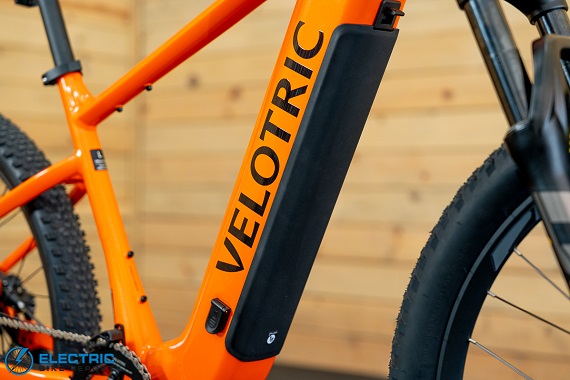
The 706 Wh battery is at peak efficiency when riding with the torque sensor engaged.
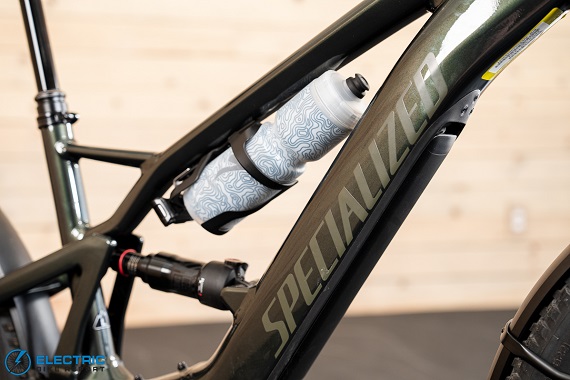
The Turbo Tero X’s 710Wh battery is uncommon for a Specialized bike as it can be removed.
Range Test Results:
| Velotric Summit 1 (conducted at Class 2 settings with the torque sensor) | Specialized Turbo Tero X 5.0 (conducted at Class 3 settings) | |
| Max PAS | 36.47 miles | 36.13 miles |
| Min PAS | 73.39 miles | 73.75 miles |
Before we begin, it’s important to note that the mileage results above were achieved under different class settings. We typically standardize Range Tests at Class 2 speeds for consistency, but we received a request to conduct our original Specialized Turbo Tero X 5.0 review using Class 3 settings. Keep this in mind during the analysis.
The Summit 1 and Turbo Tero X 5.0 are equipped with generously sized batteries and make efficient use of them. The Summit 1 features a 706Wh battery and allows the rider to choose between a torque or cadence sensor. If you run it with the torque sensor, you’ll gt better efficiency. Meanwhile, the Turbo Tero X has a 710Wh battery and, like most mid-drives, operates exclusively with a torque sensor.
The Summit 1’s performance on the Min Range Test was a pleasant surprise. Velotric estimates up to 70 miles of range in the bike’s Eco mode—the most conservative of its three programmable power levels. We achieved our result in Trail mode (the middle setting with higher output), meaning the bike exceeded expectations. On the Max Range Test, the Summit also performed well, achieving 36 miles —a solid result for higher motor usage.
The Turbo Tero X delivered nearly identical mileage but was operating at higher speeds. During its Max Range Test, the bike reached speeds of up to 28 mph (with an average speed of 23 mph), surpassing the Summit’s tested Class 2 settings that maxed at 20 mph. If we had lowered the Turbo Tero X’s max speed to 20 mph like the Summit, we’d expect even greater range results.
Regardless of how you analyze it, both bikes offer an impressive range for commuting or longer trail rides. Additionally, both bikes have the potential to achieve even better results by adjusting power outputs, as neither was tested in its most conservative settings. Overall, the mileage performance is excellent, with room for further optimization.
Velotric Summit 1 Vs Specialized Turbo Tero X 5.0: Power (Hill Test)
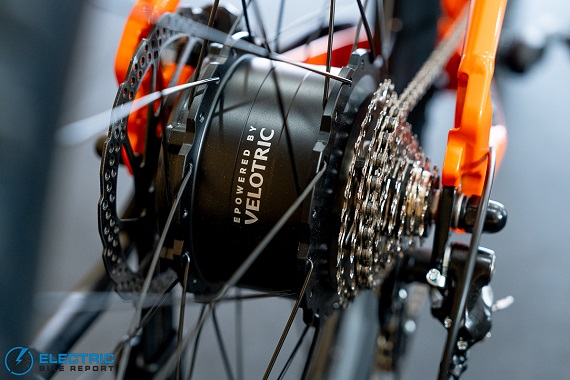
The custom Velotric hub motor has great power for speedy acceleration, and it makes for a strong hill climber.

The Specialized 2.0 motor is near the peak of seamless power integration, and it’s powerful in it’s own right.
Hill Test Results:
| Velotric Summit 1 | Specialized Turbo Tero X 5.0 | |
| Throttle | 1:09, 15.7mph | N/A |
| Pedal | 1:13, 14.9mph | 1:41, 10.7 mph |
All the bikes we review are tested on a hill with the charming name Hell Hole. It’s a third of a mile long with an average grade of 12%, and for consistency, all bikes are tested by Justin. The average time for all e-bikes we’ve tested—from cargo bikes to beach cruisers—is currently around a minute and a half. While the Summit posted the better time up the hill, I thought both bikes performed well in this test, given their respective designs. Let me explain.
In general, hub-drive motors excel in hill tests. They generate more power because they directly spin the rear wheel with less mechanical restraint. When we tested the Summit, we used its torque sensor mode, which tries to match a rider’s effort level, but it can still spin freely without the limitations of interacting with the drivetrain.
Mid-drive motors, on the other hand, tend to be slightly slower on hill climbs. These motors act as force multipliers, working in tandem with your pedaling to drive the chain and rotate the rear wheel. However, they moderate the torque to protect the chain and gears.
While both motor types help conquer steep hills, the Summit does so with more ease (and the option of just hitting the throttle), while the Tero X provides a more natural and seamless riding experience.
|
Velotric Summit 1 |
Specialized Turbo Tero X 5.0 |
Velotric Summit 1 Vs Specialized Turbo Tero X 5.0: Brakes (Brake Test)
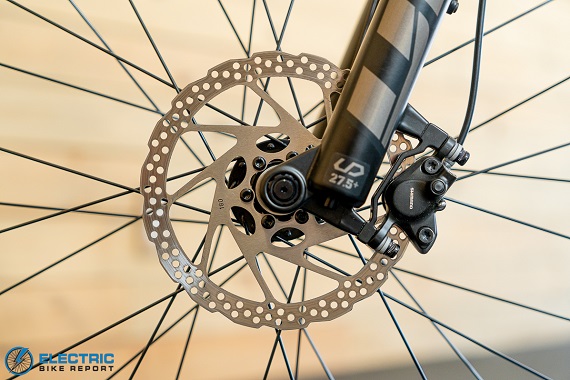
The 2-piston brake setup works reliably and is nice for commuting.
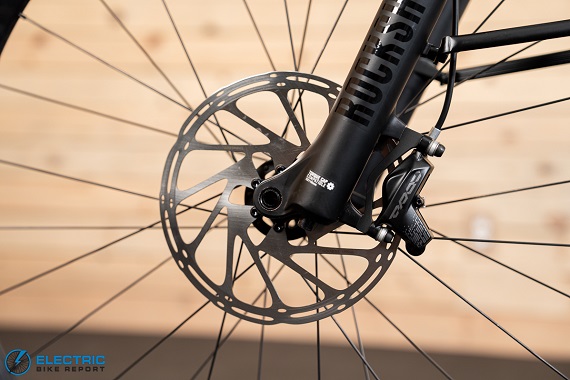
The 200/180mm rotors with 4-piston brakes have a nice bite to them, and they hold up well on tight singletrack.
| Velotric Summit 1 | Specialized Turbo Tero X 5.0 | |
| Ave Stopping Distance | 23’1″ | 21’11” |
The Turbo Tero X achieved better stopping results in our testing, but both bikes fall within what we consider safe parameters.
I’m the dedicated tester for the brake test, and after measuring the stopping distance from 20 mph (conducted three times, with the average reported), both bikes stopped within 25 feet—our minimum safety threshold.
Both bikes are equipped with hydraulic brakes, which I generally advocate for on commuter bikes and consider a full-blown necessity for anything with off-road capabilities. It’s good to see both models meeting this standard.
The Tero X’s higher price point includes an upgraded brake system with 4-piston calipers and a 200/180mm rotor setup, compared to the Velotric’s 2-piston 180/180mm configuration. While both perform well for commuting, the Turbo Tero X’s enhanced stopping power is especially valuable for tighter spaces or switchback-heavy trails. On the other hand, if you’re mostly riding greenline, the Summit’s brakes should be more than adequate.
Velotric Summit 1 Vs Specialized Turbo Tero X 5.0: Speed Capabilities (Speed Test)

The Summit is a bit better for trekking: it will happily roam HOV lands and wide open spaces where throttle use isn’t looked down upon.

The Turbo Tero X has truer eMTB potential. The travel on it puts it more in the “trail” category, but it can still navigate singletrack with its sharp handling and maneuverability.
| Velotric Summit 1 | Specialized Turbo Tero X 5.0 | |
| PAS 0 | 11.2 mph | 12.9 mph |
| PAS 1/Eco | 13.5 mph | 20 mph |
| PAS 2/Trail | 14.9 mph | 22.7 mph |
| PAS 3/Turbo | 17.6 mph | 27 mph |
| PAS 4 | 21.4 mph | |
| PAS 5 | 29.2 mph |
The goal of our Speed Test is to determine each bike’s maximum speed and evaluate the power levels of its pedal assist system. This test was conducted by two different testers: I gathered data for the Tero X, while Mike tested the Summit 1.
With the Summit’s three power profiles, the ability to toggle between torque and cadence sensors, and the difference between Class 2 and Class 3 settings, there are many possible speed profile outcomes. The Tero X also offers plenty of adjustments. To keep things simple, we’ll focus on the Class 3 results. For the Summit, we used the torque sensor and set it to the middle power profile (Trail).
Both bikes have smooth speed distribution across their various PAS levels. The Summit has the trademark easier feel of a hub motor while still feeling relatively natural with its torque sensor engaged. On the other hand, the Tero X requires a bit more effort to reach top speeds, though not to the point of being overly taxing. You’ll arrive at your destination sweat-free on either bike, though the Tero X may leave you with a slightly higher heart rate when reaching the upper power limits of each mode.
For commuting, I prefer the feel of the Summit. It’s easier to ride, provides a greater sense of power, and includes a throttle—something the Specialized lacks. However, if you’re navigating densely packed urban environments, the Turbo Tero X’s more precise control might be a better fit.
These differences extend to off-road use. The Summit excels in providing quick acceleration and power delivery, making it ideal for wide-open spaces and fun, easy rides. It feels more like a trekking bike.
The Tero X, however, offers broader MTB potential (more on that later). Its mid-drive motor is more sensitive, offering precise control that’s particularly valuable for navigating technical terrain with the scalpel-like precision of the bike’s handling in tandem with more deliberate power coming from the motor in response to the rider’s output.
|
Velotric Summit 1 |
Specialized Turbo Tero X 5.0 |
Velotric Summit 1 Vs Specialized Turbo Tero X 5.0: Components

For a bike as affordable as the Summit, it’s nice to see it comes in different sizes and color options.
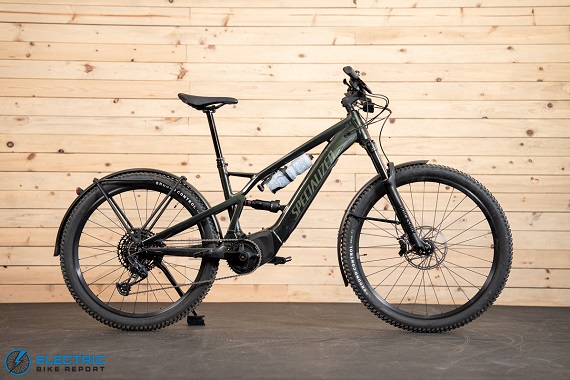
Specialized does a good job of making a bike that can wear either the commuter or mountain bike hat (helmet?).
Velotric has managed to deliver a solid trekking bike at a $1,999 MSRP. Its powerful motor makes efficient use of the 710Wh battery (tested in torque-sensing mode, which helps), and it’s equipped with solid Kenda 27.5×2.6” MTB tires that provide good traction, stability, and respectable cornering on loose surfaces.
The 8-speed Shimano drivetrain performs reliably, offering suitable gearing for both fast-paced flats and easier uphill climbs. A slightly broader gear range would have been welcome for hitting Class 3 top speeds more comfortably, but with a quickened cadence, it gets the job done.
The bike features a coil suspension fork with 120mm of travel. The UD34 Boost fork isn’t a household name in the industry, and while it’s fine for lighter applications like trekking and smoothing out rough, cracked roads, it’s not designed for jumping or overly aggressive use in the dirt. The suspension leans on the firmer side but performs fine for its intended purpose.
The key touchpoints—grips, saddle, and pedals—are all nice, offering comfort and functionality.
The Summit’s commuting aspects may require some upgrades unless you just use a backpack. Velotric doesn’t include a rack or fenders, though these are available as optional accessories. You can also upgrade to a suspension seatpost for added comfort or attach bags for carrying supplies.
When considering its performance and price, the Velotric Summit 1 proves to be a capable hybrid e-bike with room for customization to suit your needs better.
The Turbo Tero X 5.0 we tested offers significant value if a $5,500 price tag fits your budget. Specialized also offers 4.0 and 6.0 models priced a thousand less and more, respectively.
The Tero X 5.0 we reviewed includes features that push its off-road capabilities further. Three standout elements are the air fork with 130mm of travel, the 120mm rear shock, and a dropper post with 150–200mm of travel, depending on frame size.
These components provide a smoother ride and make the bike more adaptable to the rigors of XC trails. The suspension delivers a supportive yet supple feel, while the dropper post enhances control and convenience, especially for tackling drops or technical descents.
These features aren’t just beneficial off-road—they add value on-road as well. While full suspension and dropper posts are overkill for most commuter bikes, the added comfort and the convenience of lowering the seatpost at stoplights are welcome ride enhancements.
The Ground Control tires deliver excellent traction and control on dirt, and the mixed-wheel setup combines the roll-over capability of the 29” front tire with the maneuverability of the 27.5” rear tire for navigating obstacles like rocks and roots.
The SRAM GX Eagle drivetrain offers a wide 12-speed gear range, though I might have preferred a 36t chainring over the 38t it has for off-road use.
The touchpoints—grips and saddle—are solid, but the flat pedals are better suited to paved roads than off-roading. Pedals with more aggressive teeth for grip would be something I recommend.
Specialized equips the Tero X with everything you need for commuting, including fenders, a rack, and lights as standard. Optional add-ons like bags or hard-shell panniers make it easy to carry cargo on your rides.
Specialized gives you all you need for commuting, including the fenders, rack, and lights coming standard. You can add bags or hard-shell panniers, too, to take some cargo with you on the ride.
Velotric Summit 1 Vs Specialized Turbo Tero X 5.0: Ride Quality

The throttle and easy Class 3 speeds of the Summit are great for commuting.

The acceleration of the Tero X is quick in its own right, but it’s sharp delivery makes it feel great for moving about traffic and pedestrians.
The color display is sleek and functional. It has the ability to tailor the ride with multiple modes—along with toggling between torque and cadence sensors—which are uncommon but welcome features in the e-bike world. This flexibility enhances the experience, allowing riders to adjust the bike to suit their specific needs, whether for the moment or as those needs evolve over time.
Extras like Velotric’s app, which integrates with Apple Health, provides ride tracking, OTA updates, and Apple Find My for theft protection, elevate the overall experience beyond what you’d expect from an entry-level bike.
The Summit’s ride can best be described as fun, adaptable, and surprisingly capable—whether you’re navigating city streets or heading out for some light touring or trekking.
The Turbo Tero X, on the other hand, is quintessential Specialized. It’s expertly crafted and delivers an experience that feels both natural and superhuman. It’s capable of handling moderately intense trails while still being versatile enough for commuting, thanks to its comfortable geometry.
In many ways, the Turbo Tero X is the perfect recommendation for a mountain biker looking to transition from a car to a bike. It offers familiarity and comfort to ease that shift while remaining fully capable of tackling your next long XC adventure.
Velotric Summit 1 Vs Specialized Turbo Tero X 5.0: Which Should You Choose?
Decision time: which bike should you get? Let’s break it down by adding up the scorecard and narrowing in on the right buyer.
Specs: The Specialized Turbo Tero X (whether the 5.0 we tested or another model) has the undeniable advantage here. It offers features the Summit doesn’t, and where they share common features, the Tero X typically provides a more premium version. In this case, you truly get what you pay for. That said, the Summit delivers incredible value for its price, and there’s no reason to look down on what it offers.
Motor: Push. Draw. Error 404 not loading. Surprised? Don’t be—it’s just that these bikes offer very different motor experiences that appeal to different riders. It will come down to which camp you prefer with either the hub or mid-drive crowds. If you’re looking for an easier, more powerful motor, go for the Summit. On the other hand, if you value a natural ride feel (that’s still powerful in its own right), the Tero X is the better choice. If you want it even more powerful, go for the Turbo Tero X 6.0 which upgrades you to the Specialized 2.2 motor.
Hill Climbing Ability: The Summit takes this round. It climbs hills with ease and doesn’t even require you to pedal if you don’t want to. That said, the Tero X will be better for riders frequently tackling more technical climbs on MTB trails, where control is key.
Range: Advantage: Tero X. While both bikes delivered similar distances in our tests, it’s worth noting that we tested the Turbo Tero X at Class 3 speeds and the Summit at Class 2 on the Max test. Running the Summit at Class 3 speeds would likely result in fewer miles due to increased battery consumption at faster speeds.
Ride Quality: Specialized takes the win here. With a full-suspension setup and four frame sizes, the Tero X provides more comfort and a better fit for riders. That said, the Summit’s throttle and ability to toggle between torque and cadence sensors made me hesitate on this one—it’s a feature set that stands out and allows people to have their cake and eat it too.
Value for the Money: This one’s a tie. The Summit is an easy recommendation for riders seeking a versatile bike while being cost-conscious. While you might need to add a few accessories to make it fully commuter-ready, it offers an excellent riding experience for the price. The Turbo Tero X is more premium and costs what you’d expect for its features, but it’s also one of the nicest hybrid bikes I’ve ridden, which enhances the value for me. It’s equally easy to recommend for those with a higher budget to afford it.
Final Recommendations
Velotric Summit 1
The Summit 1 is ideal for new to intermediate cyclists seeking a versatile bike that does well for paved riding, but also has a playful side for camping, trekking, or flying down that old farm road or multi-use trail. Its ability to switch between torque and cadence sensors is a standout feature, making it a great choice for riders who don’t want to commit to just one type. With plenty of power, an excellent app with customization options, and standout colors, the Summit is a fantastic hybrid bike for the price.
In many ways, this is the bike I’ll likely recommend more often. It’ll be great for college kids who can only afford one ride and want to do a lot, it will be great for retirees looking to get out a little more but want something that has a little adventure to it, too. Affordable, well-made bikes with lots of programming customization will make a great option for most people, and the Summit 1 is such a bike.
Specialized Turbo Tero X
The Turbo Tero X appeals to novices and experienced riders alike who want a bike more capable of riding single-track mountain bike trails, but can be the 9-5 transport as well. It boasts a precise motor feel, excellent handling, and comes essentials-ready with accessories like a rear rack and fenders. The Specialized app adds even more functionality, making it well-suited for riders who need a bike that performs equally well on paved roads and rough terrain. For its price, it’s a premium bike worth considering.
I’d happily recommend it to current or aspiring trail riders who want a bike that’s reliable to get them all over town or through it on the road to the nearest trailhead.
Full Specialized Turbo Tero X Review
|
Velotric Summit 1 |
Specialized Turbo Tero X 5.0 |


